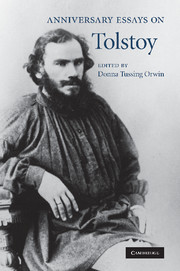Book contents
- Frontmatter
- Contents
- Acknowledgments
- List of contributors
- Introduction
- 1 Tolstoy and music
- 2 Sublime vision and self-derision: the aesthetics of death in Tolstoy
- 3 Tolstoy's peaceable kingdom
- 4 Leo Tolstoy: pacifist, patriot, and molodets
- 5 Leo Tolstoy's correspondence with Nikolai Strakhov: the dialogue on faith
- 6 The worm of doubt: Prince Andrei's death and Russian spiritual awakening of the 1860s
- 7 Tolstoy's spirituality
- 8 Tracking the English novel in Anna Karenina: who wrote the English novel that Anna reads?
- 9 Violence and the role of drama in the late Tolstoy: The Realm of Darkness
- 10 What men quote by: Tolstoy, wise sayings, and moral tales
- 11 The “proletarian lord”: Leo Tolstoy's image during the Russian revolutionary period
- Bibliography
- Index
11 - The “proletarian lord”: Leo Tolstoy's image during the Russian revolutionary period
Published online by Cambridge University Press: 03 May 2010
- Frontmatter
- Contents
- Acknowledgments
- List of contributors
- Introduction
- 1 Tolstoy and music
- 2 Sublime vision and self-derision: the aesthetics of death in Tolstoy
- 3 Tolstoy's peaceable kingdom
- 4 Leo Tolstoy: pacifist, patriot, and molodets
- 5 Leo Tolstoy's correspondence with Nikolai Strakhov: the dialogue on faith
- 6 The worm of doubt: Prince Andrei's death and Russian spiritual awakening of the 1860s
- 7 Tolstoy's spirituality
- 8 Tracking the English novel in Anna Karenina: who wrote the English novel that Anna reads?
- 9 Violence and the role of drama in the late Tolstoy: The Realm of Darkness
- 10 What men quote by: Tolstoy, wise sayings, and moral tales
- 11 The “proletarian lord”: Leo Tolstoy's image during the Russian revolutionary period
- Bibliography
- Index
Summary
Too, those who are caught by Tolstoy's eyes, in the various portraits, room after room after room, are not unaffected by the experience. It is like, people say, committing a small crime and being discovered at it by your father, who stands in four doorways, looking at you.
Barthelme, “At the Tolstoy Museum”Leo Tolstoy figured large in the deeply partisan and impassioned debates during the Russian revolutionary period (1917–24). In the uncharted social and political chaos of disappearing and emerging institutions, competing centers of authority vied for validation and credibility by reciting and creating stories about Tolstoy: how he foretold the Revolution, warned against it, or caused it; why he would have rejected or embraced it; what he would have said or done had he lived to see it. Regardless of political position, these commentators saw Tolstoy as the code that, when correctly interpreted, offered a truer understanding of the Revolution's cipher, because both Tolstoy and the Revolution were equally products of a uniquely Russian experience.
An examination of the stories people told about Tolstoy in primary historical documents from the Russian and international press provides a fuller and more nuanced historical understanding of debates about the authenticity, inevitability, and justness of the Russian Revolution. While the storytellers intended only to influence the perception of the Revolution by invoking Tolstoy, making what was new and unfamiliar into something comprehensible by referencing something known, these stories nonetheless altered Tolstoy's image as well.
- Type
- Chapter
- Information
- Anniversary Essays on Tolstoy , pp. 219 - 244Publisher: Cambridge University PressPrint publication year: 2010
- 4
- Cited by



